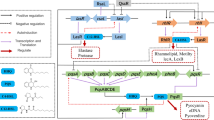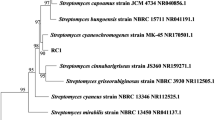Abstract
The biofilm formation of Pseudomonas aeruginosa, an opportunistic human pathogen, is developed by cell-to-cell signaling, so-called quorum sensing (QS). To control the biofilm formation, we designed and synthesized new QS inhibitors of P. aeruginosa based on the structure of the previously known QS inhibitor, furanone. Newly synthesized compounds were a series of analogs of (5-oxo-2,5-dihydrofuran-3-yl)methyl alkanoate, and the structures of all six synthesized compounds was confirmed by NMR and GC/MS analyses. These new QS inhibitor candidates could remarkably inhibit both Pseudomonas QS signaling and biofilm formation, which were assayed by using the recombinant reporter system and flow cell confocal microscopy. The degree of QS inhibition by these new inhibitors varied from 20% to 90%. For the profound understanding about inhibition mechanism, we tried to estimate the binding energy between QS receptor, LasR, and our inhibitors from the in silico modeling system. The predicted binding pattern from the modeling system and our experimental data about QS inhibition were in good agreement. From these results, we suggest a new approach to develop the QS inhibitors and biofilm control agents based on structural modeling.







Similar content being viewed by others
References
Chugani SA, Whiteley M, Lee KM, D’Argenio D, Manoil C, Greenberg EP (2001) QscR, a modulator of quorum-sensing signal synthesis and virulence in Pseudomonas aeruginosa. Proc Natl Acad Sci USA 98:2752–2757
Fuqua C (2006) The QscR quorum-sensing regulon of Pseudomonas aeruginosa: an orphan claims its identity. J Bacteriol 188:3169–3171
Fux CA, Costerton JW, Stewart PS, Stoodley P (2005) Survival strategies of infectious biofilms. Trends Microbiol 13(1):34–40
Gadir SA, Smith Y, Taha AA, Thaller V (1986) Synthesis of 4-hydroxymrthylfuran-2(5H)-one, a metabolite of the Celastraceae Siphonodon australe. J Chem Res 6:222–223
Givskov M, Eberl L, Molin S (1997) Control of exoenzyme production, motility and cell differentiation in Serratia liquefaciens. FEMS Microbiol Lett 148:115–122
Grabski A, Mehler M, Drott D (2005) The overnight express autoinduction system: high-density cell growth and protein expression while you sleep. Nature Methods 2:233–235
Huang X, Sheng S (2003) A facile solid-phase synthesis of substituted 2(5H)-furanones from polymer-supported selenocarboxylic acids. J Comb Chem 5:273–277
Jacek S, Markus B, Isabel S, Hans-Martin D, Martin S (2001) Synthesis, molecular modeling, and structure-activity relationship of benzophenone-based CAAX-peptidomimetic farnesyltransferase inhibitors. J Med Chem 44:2886
Kim C, Kim J, Park HY, McLean RJC, Kim CK, Jeon J, Yi SS, Kim YG, Lee YS, Yoon J (2007) Molecular modeling, synthesis, and screening of new bacterial quorum-sensing antagonists. J Microbiol Biotechnol 17:1598–1606
Lee JH, Lequette Y, Greenberg EP (2006) Activity of purified QscR, a Pseudomonas aeruginosa orphan quorum-sensing transcription factor. Mol Microbiol 59(2):602–609
Llovera M, Balcells M, Torres M, Canela R (2005) Parallel synthesis: a new approach for developing analytical internal standards. Application to the analysis of patulin by gas chromatography–mass spectrometry. J Agric Food Chem 53:6643–6648
Ma S, Duan D, Shi Z (2000) Palladium(0)-catalyzed cyclization reaction of polymer-supported aryl iodides with 1,2-allenyl carboxylic acids. A facile solid-phase synthesis of butenolides. Org Lett 2:1419–1422
Ma S, Duan D, Shi Z, Wang Y (2002) Palladium(0)-catalyzed coupling-cyclization reaction of polymer-supported aryl iodides with 1,2-allenyl carboxylic acids. Solid-phase parallel synthesis of butenolides. J Comb Chem 4:239–247
Mannhold R, Rekker RF, Sonntag C, ter Laak AM, Dross K, Polymeropoulos EE (1995) Comparative evaluation of the predictive power of calculation procedures for molecular lipophilicity. J Pharm Sci 84:1410–1419
McDougald D, Rice S, Kjelleberg S (2007) Bacterial quorum sensing and interference by naturally occurring biomimics. Anal Bioanal Chem 387:445–453
Mizuguchi K, Deane CM, Blundell TL, Johnson MS, Overingon JP (1998a) JOY: protein sequence-structure representation and analysis. Bioinformatics 14:617–623
Mizuguchi K, Deane CM, Blundell TL, Johnson MS, Overingon JP (1998b) A database of protein structure alignments for homologous families. Protein Sci 7:2469–2471
Montalvao RW, Smith RE, Lovell SC, Blundell TL (2005) CHORAL: a differential geometry approach to the prediction of the cores of protein structures. Bioinformatics 21:3719–3725
Morley KL, Magloire VP, Guerard C, Kazlauskas RJ (2004) Parallel synthesis of esters by solution-phase acylation of alcohols with acid chlorides using solid-supported reagents to eliminate traditional purification. Tetrahedron: Asymmetry 15:3005–3009
Persson T, Hansen TH, Rasmussen TB, Skinderso ME, Givskov M, Nielsen J (2005) Rational design and synthesis of new quorum-sensing inhibitors derived from acylated homoserine lactones and natural products from garlic. Org Biomol Chem 3:253–262
Rasmussen TB, Skindersoe ME, Bjarnsholt T, Phipps RK, Christensen KB, Jensen PO, Andersen JB, Koch B, Larsen TO, Hentzer M, Eberl L, Hoiby N, Givskov M (2005) Identity and effects of quorum-sensing inhibitors produced by Penicillium species. Microbiology 151:1325–1340
Schrauber H, Eisenhaber F, Argos P (1993) Rotamers—to be or not to be: an analysis of amino acid side-chain conformations in globular proteins. J Mol Biol 230:592–612
Schuster M, Greenberg EP (2006) A network of networks: quorum-sensing gene regulation in Pseudomonas aeruginosa. Int J Med Microbiol 296:73–81
Shi J, Blundell TL, Mizuguchi K (2001) FUGUE: a sequence–structure homology recognition using environment-specific substitution tables and structure-dependent gap penalties. J Mol Biol 310:243–257
Singh PK, Schaefer AL, Parsek MR, Moninger TO, Welsh MJ, Greenberg EP (2000) Quorum-sensing signals indicate that cystic fibrosis lungs are infected with bacterial biofilms. Nature 407(6805):762–764
Singh R, Paul D, Jain RK (2006) Biofilms: implications in bioremediation. Trends Microbiol 14:389–397
Speranza G, Gottardi G, Pederzolli C, Lunelli L, Canteri R, Pasquardini L, Carli E, Lui A, Maniglio D, Brugnara M, Anderle M (2004) Role of chemical interactions in bacterial adhesion to polymer surfaces. Biomaterials 25:2029–2037
The Center for Biofilm Engineering, Standardized Biofilm Methods Team for BioSurface Technologies, Inc (2003) CDC biofilm reactor operator’s manual
Venturi V (2006) Regulation of quorum sensing in Pseudomonas. FEMS Microbiol Rev 30:274–291
Whiteley M, Lee KM, Greenberg EP (1999) Identification of genes controlled by quorum sensing in Pseudomonas aeruginosa. Proc Natl Acad Sci USA 96:13904–13909
Williams MG, Shirai H, Shi J, Nagendra HG, Mueller J, Mizuguchi K, Miguel RN, Lovell SC, Innis CA, Deane CM, Chen L, Campillo N, Burke DF, Blundell TL, de Bakker PIW (2001) Sequence–structure homology recognition by iterative alignment refinement and comparative modeling. Proteins 5:92–97
Winsor GL, Lo R, Sui SJ, Ung KS, Huang S, Cheng D, Ching WK, Hancock RE, Brinkman FS (2005) Pseudomonas aeruginosa Genome Database and PseudoCAP: facilitating community-based, continually updated, genome annotation. Nucleic Acids Res 33(Database Issue):D338–D343
Ymele-Leki P, Ross JM (2007) Erosion from Staphylococcus aureus biofilms grown under physiologically relevant fluid shear forces yields bacterial cells with reduced avidity to collagen. Appl Environ Microbiol 73:1834–1841
Zhang RG, Pappas T, Brace JL, Miller PC, Oulmassov T, Molyneaux JM, Anderson JC, Bashkin JK, Winans SC, Joachimiak A (2002) Structure of a bacterial quorum-sensing transcription factor complexed with pheromone and DNA. Nature 417:971–974
Acknowledgments
This research was partially supported by the Brain Korea 21 Program (the Ministry of Education). In addition, this work was supported by the Korea Science and Engineering Foundation (KOSEF) grant funded by the Korea government (MOST; no. R01-2007-000-20732-0). The authors wish to acknowledge the financial support by the Seoul R&D Program (10538) through the Institute of Bioengineering, Seoul National University, Seoul, South Korea. For Joon-Hee Lee, this work was supported by the Korea Research Foundation Grant funded by the Korean Government (MOEHRD) (KRF-2007-331-C00222).
Author information
Authors and Affiliations
Corresponding author
Rights and permissions
About this article
Cite this article
Kim, C., Kim, J., Park, HY. et al. Furanone derivatives as quorum-sensing antagonists of Pseudomonas aeruginosa . Appl Microbiol Biotechnol 80, 37–47 (2008). https://doi.org/10.1007/s00253-008-1474-6
Received:
Revised:
Accepted:
Published:
Issue Date:
DOI: https://doi.org/10.1007/s00253-008-1474-6




